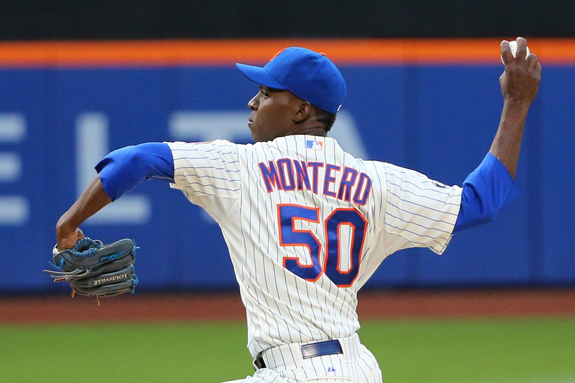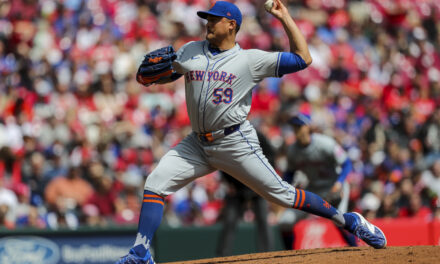In what is becoming an ongoing commentary on the effectiveness of the Mets braintrust’s primary approach to returning the organization to relevance, namely their institutional focus on pitching, we are poised for yet another test. Over the past few days the Mets have been hit with a mixed bag of essentially bad news on the pitching front with their ROY candidate Jacob deGrom going down with elbow tendinitis, their closer Jenrry Mejia disclosing a sports hernia, and Jeremy Hefner looking like he’s headed for another TJ surgery.
How well the Mets weather this incursion into their vaunted pitching depth will go a long way in revealing whether our arms stockpile is in fact paying off. The Mets, who continue to be one sweep of the Nats (granted easier said than done) from climbing into the thick of it, already have their pitching to thank for this hanging around consolation, but whether Montero can step into deGrom’s rotation spot and tread water will be a considerable measure of the quality of our development programs.

Montero is an interesting case in his own right. This time last year Montero was a far greater subject of major league projections than deGrom — a converted infielder with elbow surgery in his past. Montero’s performance in spring training was, to me, eye opening because as with any young control pitcher you worry about major league hitters clobbering him, but Montero showed persistence and resilience, bending but not breaking, (much like early Wheeler — before his transformation into a different animal).
Then came his stint in the majors, which was, in a word, puzzling. He appeared to be avoiding the inside part of the plate, was missing the corners, getting behind hitters. It was … like nothing we’d been led to expect from this kid. And now he’s back after a string of masterful Triple-A starts, another potential testament to this organization’s ability to develop major league starters, if he can stick. The question now being asked after last night’s homer-fest is whether Montero was tipping his pitches.
At a time in the season when attrition rears its ugly head, like ruts in a muddy road pulling a bus full of nuns this way and that, some teams will be able to stay on track while others will end up in a ditch, all depending on the quality of their replacement tires and how well they’ve plugged their holes.
The Mets have some arms, clearly, and, clearly, the organization’s reluctance to trade from strength is looking like a sound decision, but a team that can absorb the loss of a player performing at a level as high as deGrom should open some eyes at the very least, boosting said team’s pitching stock. Or, the team could falter, Montero could revert to his nibbling, timid, earlier performance … our replacements could struggle, a blowout here, a cracked radiator there, the dream of a pennant race could careen precariously off a bridge and tip slowly into the churning waters of insignificance.
It’s not enough to have lots of arms. You have to have lots of really good arms. Pitchers not throwers as the old adage goes. deGrom, Gee, Wheeler all show the ability to mix their pitches, and in the end, that’s how you get major league hitters out. Is that a reflection of a revamped system, or simply a case of amassing some talented hurlers on one rotation? You show a major league hitter the same thing over and over, they’ll eventually figure out how to hit it … you learn how to spot a changeup and when to drop a breaking pitch and when to come up and in, you’ll have hitters off balance more often than not. It’s all about development at this stage of the great Mets pitching endeavor … the arms are there, will they continue to perform at this ridiculously high level?
We’ll know soon enough.














